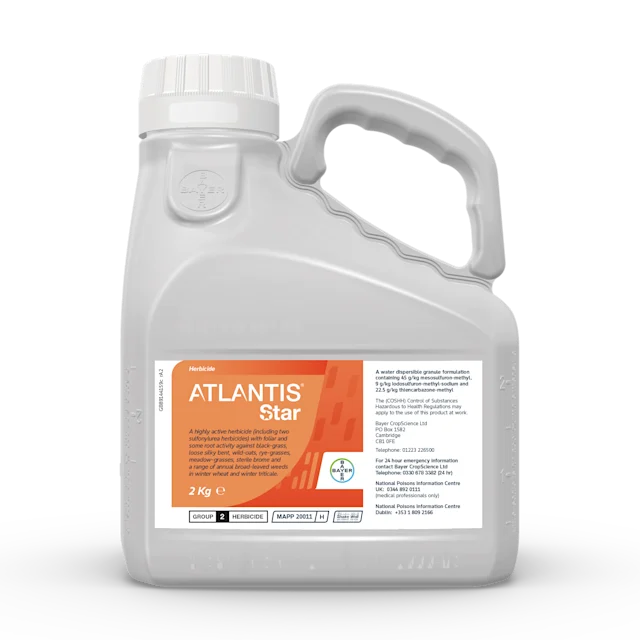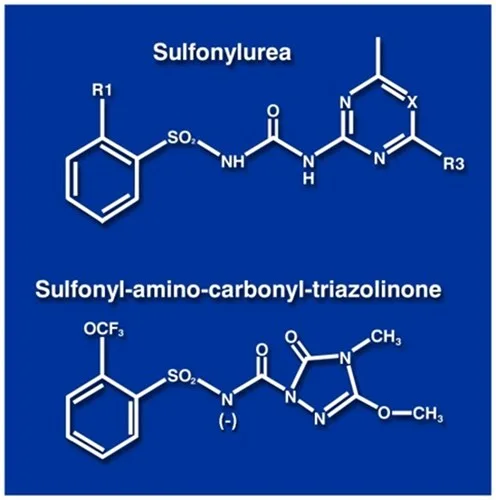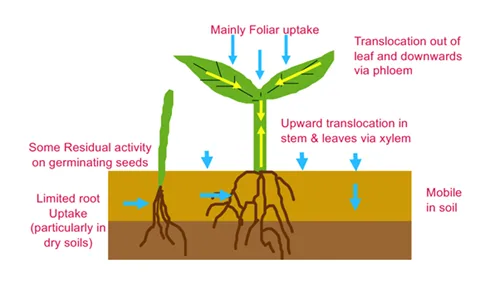

Atlantis Star
A highly-effective herbicide for control of grass-weeds and broad-leaf weeds in winter wheat. Atlantis Star is a coformulation of three ALS-Inhibitors (HRAC Group 2) with foliar and some root activity
Product details
Atlantis Star contains three actives – mesosulfuron, iodosulfuron and thiencarbazone – compared to just mesosulfuron and iodosulfuron in Atlantis. Applied at label rate, Atlantis Star provides a higher dosing of mesosulfuron and the addition of thiencarbazone improves control of grass-weeds and broad-leaf weeds. Atlantis Star is unique in containing three actives with activity on grass-weeds, and trials show it provides additional activity even where enhanced metabolism resistance is an issue.
Atlantis Star contains thiencarbazone alongside mesosulfuron and iodosulfuron, whereas Pacifica Plus, also a three-way mix, contains mesosulfuron, iodosulfuron and amidosulfuron. At full label rate, both deliver the same amount of mesosulfuron. Thiencarbazone (TCM), unlike amidosulfuron, has good activity on grass-weeds and enhances control of bromes, ryegrasses and black-grass. TCM also has activity on a wide range of broad-leaf weeds, although the spectrum is different to amidosulfuron, so consult the label carefully where broad-leaf weeds are part of the target population.
Atlantis Star has no additional restrictions relating to timing, application technique and following crops in comparison with Pacifica Plus.
Thiencarbazone (TCM) is a grass-weed active that is new to the UK but is widely used in Europe, particularly in maize crops. It is an ALS-inhibitor (HRAC Group 2) like mesosulfuron and iodosulfuron but has but a different structure. Mesosulfuron and iodosulfuron are sulfonylureas while, TCM is a sulfonyl-amino-carbonyl-triazolinones thus there is a potential improvement when controlling weeds with metabolic resistance.
Its main effect is through foliar uptake, but there is also some uptake through the roots and a small amount of residual activity on newly-emerging weeds.


Because it is an ALS-Inhibitor, TCM is still affected by both target-site and enhanced metabolism resistance. Unlike mesosulfuron, it is not a sulfonyl-urea which may have a small benefit in controlling weeds with metabolic resistance.
In broad-leaf weeds, isolated cases of target-site resistance have been found in Europe, but generally TCM retains good activity across a wide range of weeds. If you think you may have resistance in any weed, do a resistance test to check the status.
Testing from Bayer and NIAB has demonstrated that resistance is not always the reason for poor control. In tests from 2021 and 2022, 10% of black-grass samples suspected of resistance were, in fact, susceptible. Over the same period, over 50% of ryegrass samples tested were still susceptible, indicating that ALS-Chemistry can still provide valuable control on many farms.
Farmers can apply the full rate of Atlantis Star, 0.333kg/ha, from 1 February, GS21–33 of winter wheat. The full rate delivers 15g mesosulfuron + 3g iodosulfuron + 7.5g thiencarbazone. This is the same rate of mesosulfuron that is in Pacifica Plus which is only approved at full rate from 1 March. Like other post-emergence herbicides, smaller weeds are generally more susceptible, so aim to apply as soon as conditions allow in spring.
Atlantis Star is a water dispersible granule formulation and application guidance is similar to other products in the ‘Atlantis family’ including Pacifica Plus. Apply as a fine-medium spray, typically from a flat fan nozzle. Active growth and sufficient drying time, at least two hours, ideally four, are essential to getting a good result.
Lack of active growth after prolonged cold weather means that the target weed will not take in the herbicide, so it will have no effect. Likewise, dew or rain shortly after application will wash the herbicide off the weed before it is full absorbed by the leaf.
Correct boom height, approximately 0.5 metres and forward speed no more than 12 km/hr help to ensure even coverage with the correct spray quality to land and settle on the relatively small target leaf.